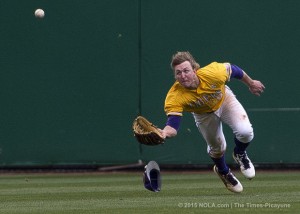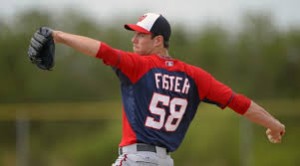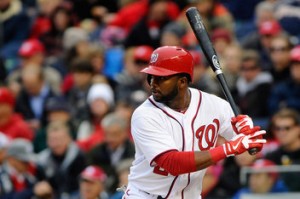
LSU’s Andrew Stevenson becomes the Nats highest 2015 draft pick. Photo via nola.com
As we did for the 2013 draft, and again in 2014, here’s a quick introduction to the Nats top 10 picks for 2015.
Here’s a slew of Draft Prospect rankings that I’ll refer to later on.
As he did last year, NatsGM.com‘s Ryan Sullivan live-blogged the draft and does a great job of pulling up stats and observations on each pick.
Draft Links of importance
- MLB.com Official 2015 Draft Central home page.
- MLB’s Awesome Draft Tracker; you can slice and dice the draft 10 different ways, search by schools and home states, etc.
- Official MLB 2015 Draft Order (Nats first pick is #58 well into the 2nd round, next #69, then #103, then #134 in the 4th round, and then 134+30 picks there-after.
- Official Draft Bonus Pool totals. Astros have $17M (most). Nats have 3rd least at $4.1M.
- MLB Draft Database
- Fangraphs Sortable Draft Board; a great new tool Fangraphs has that lets you slice and dice their top draft board.
- Baseball-Reference Draft Tools: links to their draft database plus some custom reports.
- Baseball America’s Draft Database for 2015; this will get updated with bonus amounts when the players sign.
Lets get to it!
1st round/#26 overall: in what would have been the Nationals first round pick had they not signed Max Scherzer and forfeited their pick, the Los Angeles Angels went way off-board and picked Taylor Ward, a Catcher from Fresno State. He’s not even in Keith Law’s top 100 and is mostly in the 75-100 range of other ranking services, and players like Mike Nikorak, John Harris, Kyle Funkhouser, Daz Cameron and Mike Matuella (a Nationals special; a big righty with power and a Tommy John surgery) still on the board. Unlike two years ago when I complained bitterly about the loss of the 1st rounder, here Scherzer is more than proving his worth and I’m not as worried about the loss of this pick in a weak draft. But I wouldn’t have minded seeing how Harris or Funkhouser worked out.
2nd round/#57 overall: Andrew Stevenson, Jr. OF (CF) from LSU (hometown Youngsville, LA). Rankings: Law outside #100, MLB #79, BA #168, Sickels #101, Draft Rpt #115. A slightly built slap hitter who plays excellent CF for LSU but, from my limited observations, looks like he’s destined to be a spare outfielder at best. More than one of the above draft guides mentioned Ben Revere as a comparison. (This was the comp pick for last year’s non-signing of Andrew Suarez … who went 4 picks later). FWIW, Law said he “fell out of his chair” when he saw the Nats taking him here. I can only surmise what the team sees here; perhaps they got a deal on him and will apply some of the savings down the road.
2nd round/#69 overall: Blake Perkins, Prep OF (CF) from Verrado AZ HS (hometown: Phoenix, AZ). Rankings: Law #96, MLB #162, BA #137, Sickels #148, Draft Rpt #283. Perkins profiles similarly to Stevenson: slight build, very fast, great fielder, decent arm and a questionable hit tool. He’s committed to Arizona State and hails from the Phoenix suburbs. For what its worth, in Keith Law’s post-round 2 write-up, he specifically called out this pick as being a very good one. But, he’s still *way* overdrafted according to most of the rankings.
3rd Round/#103 overall: Rhett Wiseman, Jr. OF (corner) from Vanderbilt (Hometown Mansfield, MA). Rankings: Law outside #100, MLB #120, BA #88, Sickels #92, Draft Rpt #146. Developed big-time power his junior year at Vanderbilt. Probably projects as a LF but is no bigger than the CF draftees the Nats already have picked.
4th round/#134 overall: Mariano Rivera, JR, Jr. RHP (starter) from Iona (Hometown Harrison NY by way of the D.R.) Rankings: Law #93, MLB #170, BA #142, Sickels #215, Draft Rp #198. Well, you can’t argue with the pedigree. He’s stepped it up this year as a junior with a huge velocity spike and *will* sign, but he barely weighs more than my labrador and one wonders if he can withstand the rigors if pitching in the pros. Very little mileage on the arm (he didn’t pitch until he got to college reportedly). Interesting pick.
5th round/#164 overall: Taylor Hearn, Jr. LHP starter from Oklahoma Baptist (Hometown Royse City, TX). Rankings: … well, nobody ranked this kid. Not even on the top 500 prospect list. He was 9-0 for the NAIA team with good K/9 rates. Not much else to be said. The Nats have drafted twice before players from this school (Richie Mirowski and Matthew Page) with decent success and clearly have a scout working that area with success. Is this a signability/money saving pick? But for whom? Perkins?
6th round/#194 overall: Matt Crownover, Jr. LHP starter from Clemson (Hometown: Ringgold, Ga.). Rankings: BA #344, Draft Rpt #161. Great numbers at Clemson: 10-3 with a 1.82 ERA. Tommy John survivor, undersized. Perhaps projects as a future reliever.
7th round/ #224 overall: Grant Borne, Jr. LHP starter from Nichols State (Hometown: Baton Rouge, LA). BA #348, otherwise unranked. Another mystery player. 6-5 with a 1.48 ERA as a starter for Nichols State.
8th round/#254 overall: Koda Glover, Sr. RHP Oklahoma State (Hometown: Heavener, OK). Sickels #297, otherwise unranked. Glover was a back-end reliever for Oklahoma State, having transferred in after two years at Juco. MLB says he’s a senior, OK State says he’s a junior. Either way, he’s a reliever who could be quicker to the majors, which isn’t too bad a pick for the 8th round.
9th round/#284 overall: David Kerian, Sr. switch hitting 1B from Illinois (Hometown: Dakota Dunes, SD). He hit .366 with 14 homers on the year for one of the best teams in the country. Not a bad pick.
10th round/#314 overall: Taylor Guilbeau, Sr lefty starter from Alabama (Hometown Slaughter, LA): nice sign here, getting a Friday starter in the SEC. 3-6 with a 3.69 ERA on his senior season, which ended in the SEC playoffs for Alabama this year.
Breakdown by position:
- Three outfielders, two definite CFs and one corner OF.
- One 1B who could feature as a corner OF
- Five college starters: four LHP and one RHP
- One college reliever (RHP)
His first three picks were outfielders … then 6 of the next 7 were arms. Mostly left-handed college starters. How many of these starters will profile as pro relievers? Probabaly a few of them; Rivera for sure, likely Crownover, probably Guilbeau as well.
Breakdown by Player Demographic
- One Prep/HS player
- Six College Juniors, all four-year college picks
- Three College Seniors, all from four-year colleges
Well, Rizzo likes college grads, and this shows it. ONE prep player out of his first 10 picks.
Breakdown by Region
- Southeastern US: 1 from LSU, 1 from Vanderbilt, 1 from Clemson, 1 from Nichols State, 1 from Alabama
- Midwest: 1 from Oklahoma Baptist, 1 from Oklahoma State, 1 from Illinois
- Southwest: 1 from Arizona
- Northeast: 1 from Iona College
Its amazing to me, year after year we seem to see this. The Nats draft so heavily from the southeast and midwest. Meanwhile, everyone knows that the two best states for prospects are California and Florida. If you look at the home towns of these top 10 picks, still nobody from the two major baseball states and just one guy who hails from Texas. I guess Rizzo really trusts his area scouts down there.
Summary
Well, like in 2013 when you don’t have a 1st round pick … you’re not likely to end up with a name that you’ve heard in the pre-draft coverage. And I hadn’t heard of practically any of these guys prior to seeing their names read. Picks 8-10 seem like typical low-value senior signs, but you have to wonder where the draft bonus dollars are going here. Is everyone signing for slot? Are there any risky picks here?








